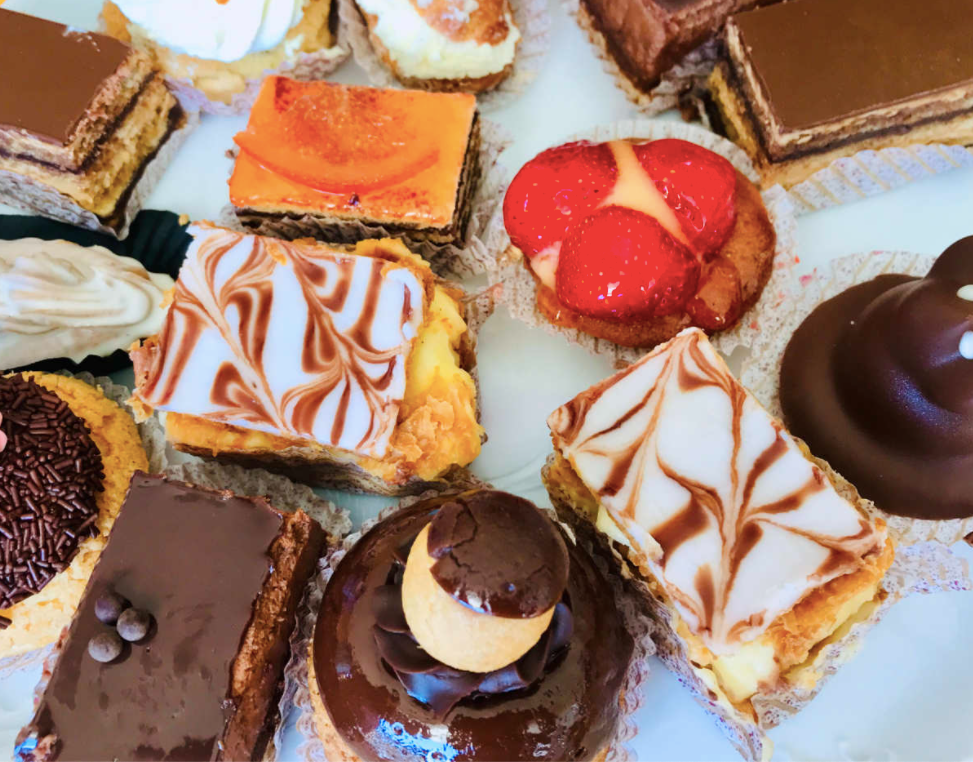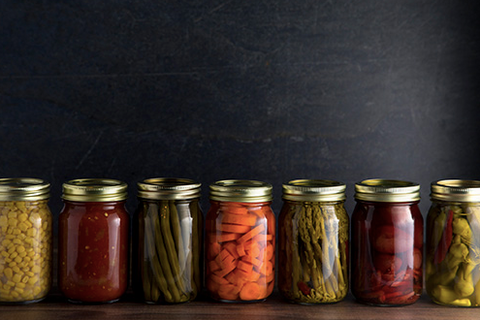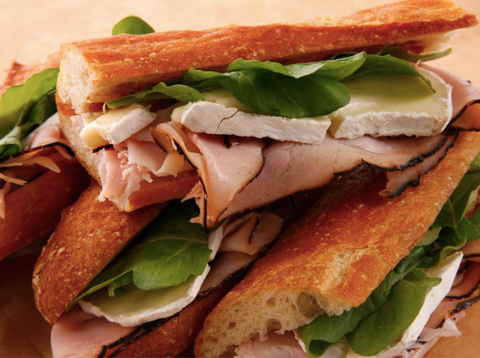French Sweets to Buy
France is home to some of the world's most famed desserts and pastries, including crème brûlée, macarons, madeleines, and éclairs. Paris alone has more than 300 shops dedicated to just chocolate.
We have a great collection of French Sweets at Mon Panier Latin, but there are a lot of other sweets you can bring back from France (and Europe in general) that you might not have heard of yet. Here are a few that should be on your radar next time you're in France:
Mendiants: These little round cakes are topped with dried fruit and nuts — often raisins, hazelnuts, almonds, and candied orange peel. They're often given as gifts around Christmas time.
Galettes des Rois: These round puff pastry desserts are filled with frangipane (almond cream). Tradition says that a trinket is hidden inside one of the galettes, and whoever gets the piece with the trinket is crowned king for the day.
Langues de Chat French Cookies: You'll find these cookies in every French café or patisserie. They're made with flour, sugar, and egg white, shaped into little cat tongues and baked until crisp.
Most popular sweets in France
There are a lot of different kinds of sweets in France, but the most popular sweet is the macaroon. Macaroons are made from almond and cocoa powder. Macaroons are usually round-shaped, and they are very soft. It is very famous in France, and it is sold in a lot of shops around Paris too!
The French live in a culture where food and pastry, bread, and wine are all important. The French spend more of their income on food (and drink) than any other country. However, we are worried about obesity: more than 50% of us are overweight (and two-thirds of children).
According to a survey ordered by the DGCCRF (Ministry of Economy), here is a list of our favorite sweets:
- Chocolate bars
- Candy/chewing gum
- Caramel
- Ice-cream cake
- Chocolate spread
- Pâtes de fruits/candied fruit
- Chocolate/caramel spread
- Soft drinks/syrups
- Sugar-coated cereal
- Jelly beans
What sweets are from France?
Here are some sweets from France:
Baba au rhum
A small cake soaked in rum syrup made with yeast dough and often filled with raisins and candied fruit.
Baba au rhum is a small cake soaked in rum syrup, made with yeast dough, and filled with raisins and candied fruit. It is a specialty of the south of France and is also eaten in Belgium, the Netherlands, Switzerland, Germany, Denmark, Sweden, Norway, and Finland. In the Balkans, it is known as "rum baba". The name means literally "rum grandmother" or "rum babysitter."
The cake is similar to savarin. Both are yeast cakes soaked in alcohol; however, savarin is baked in a ring mold.
Crème brûlée
Crème brulee is custard topped with a layer of hard caramel. A crème brûlée, also known as burnt cream, creme Catalana, or Trinity cream, is a dessert consisting of a rich custard base topped with a contrasting layer of

What kind of candy does the French eat?
The French eat candy, of course. But what kind of candy do the French eat?
France is a country with a long, rich history of candy dating back to the middle Ages. France is where sugar was first introduced to the Western world in the 10th century. Since then, the country has developed a robust confectionery tradition that includes everything from traditional French candies (like caramels and nougat) to more modern offerings like fruit chews and licorice.
The following are some of the most popular types of candy in France:
Caramel (confection): Caramel is one of the oldest sweets in France and can be found in various forms throughout the country. Caramels can be eaten by themselves or used as an ingredient in other confections such as chocolate bars, ice cream, and pastries.
Nougat (confection): Nougat is a type of confection made from nuts, honey, and egg whites that have been around since ancient times. It's often enjoyed as part of a dessert course after dinner with coffee or tea and can also be used to make other desserts like cakes and cookies. Seriously Delicious Candy You Have to Try in France
Candy shops are a staple of French life. Many have been around for hundreds of years, and they're perfect places to try an unusual or hard-to-find sweet treat. The gourmets of Paris have the option to indulge in anything from chocolate truffles to fresh fruit platters.
However, despite their ubiquity, candy shops are often overlooked as tourist destinations. If you're looking for something special while you're in Paris, it can be tough to find a store that can match the creations of its French counterparts.
What you find on Rue de Rivoli (map) is nothing less than pure magic: a handful of shops that make up one of the best candy shops in Paris.
Here are my recommendations for where you should go when you're in Paris looking for something sweet:
This store is located near the Galeries Lafayette department store and on Rue de Rivoli itself, making it easy to grab a quick bite before or after shopping. Though the shop's name sounds like a hipster candy store, it's been owned by the same family for over 50 years. The two brothers behind Le Bonbonnière have turned out great treats like pralines in flavors such as dark.
The recipe for this soft rhomboid sweet has remained unchanged since its origins, which by some accounts hark back to the 12th century in Aix-en-Provence.
This soft rhomboid sweet combines syrup, flour, and egg whites. It consists of two parts; the outside shell is a mixture of egg white and flour, while the inside consists of a powdered sugar and cinnamon mixture. Once baked, this pastry is decorated with pistachios and served with vanilla or raspberry sauce. This pastry has been produced for centuries in Aix-en-Provence in France.
I've never been a big fan of nougat, but some of my friends love it, so I thought I'd give the Nougat de Montelimar a try. The first thing that struck me was the packaging. At first glance, it was just a large brown paper bag with a label on it, but upon closer inspection, there were all sorts of great information about the famous French confectioner and pictures of their shop in Montelimar.
The texture is fascinating. It looks like ice when it's first unwrapped from its paper package, but after taking a bite, you find it's much softer than ice. It's also very chewy — almost like chewing gum! The flavor is pretty good. To me, it doesn't taste like nougat — more like honey, almonds, and vanilla. There are plenty of bits of nuts mixed in with the honey and vanilla, which adds some nice texture as well.
Overall, this is one of my favorite candies, and I will be repurchasing this!
These anise-flavored candies are like a French version of Sweet TARTS. They're also available in other flavors, including mint, orange blossom, lemon, and licorice. They're a tad addicting, so beware.
These gummy bears are a hit with the kids. Who hasn't dreamed of trying a vomit-flavored jelly bean? There's also booger, earwax, and dirt, among other flavors that don't need much explanation.
These are gluten-free and the perfect treat for a class party or after-school snack. I love the packaging!
You can get these in milk chocolate or dark chocolate. Dark chocolate is my favorite!
A rich, intensely flavored, buttery caramel can be tricky to make, but once you've mastered the basics, you can doctor them up in many ways. Adding a small amount of heavy cream or milk in addition to the butter gives them a smoother texture and also makes them easier to chew.
Salt brings out the sweetness and adds a hint of complexity that makes these candies irresistible. You can use a flavored salt, such as smoked sea salt or lemon pepper salt, if you like. But keep it subtle; a little goes a long way.
What is the famous sweet in Paris?
France is famous for its sweet delights, but nothing comes close to the taste of a Paris-Brest.
This cream-filled heaven ring dates back to 1910 when it was created to celebrate the first Paris-Brest cycling race. It wasn't until 1925 that chef Louis Durand decided to use the same ingredients to make a dessert.
Named after its wheel-like shape, this pastry has since become one of France's most treasured treats. Here are five reasons why you should try it.
Macarons: Paris is famous for many things, but one of the most delicious is the macaron, a sweet cookie made of almond flour and sugar and sandwiched around a layer of ganache, buttercream, or jam.
Macarons can be found in almost every bakery and patisserie in Paris. They come in a dozen different flavors, from classic chocolate to more exotic varieties like rose, Violette, pistache, etc.
If you're looking to try macarons, check out Pierre Hermé (the most famous patisserie in Paris), Ladurée (the oldest bakery), or La Durée (the newest).
The rum baba: One of the most famous desserts to eat in Paris, the rum baba was invented by the city's oldest pâtisserie Stohrer. Created by King Louis XV's pastry chef Nicolas Stohrer, a yeast pastry soaked in rum. Forget about the cake stuffed with rum-soaked raisins and nuts. This is the real deal. Pâtissiers and bakers who are experts in their craft can come up with crazy, sometimes absurd creations, but this is one you'll want to eat.
Rum babas are one of the most famous desserts in Paris. The original recipe was created by the city's oldest pâtisserie, Stohrer, and its popularity spread to the rest of France. There are two everyday rum baba recipes. The first is a yeast pastry soaked in rum, and another is a sweet pastry filled with sugar.
The pastry is several layers of dough with a filling made from sugar, almonds, raisins, and spices. It's baked until it browns around the edges, then cooled and sprinkled with sugar before serving.
It's traditional for customers to eat them at room temperature, but I've never had any warm or hot when I ordered them from a French patisserie (I like them cold). If you're in Paris and want to try one, be sure to order one at least an hour before you get your dessert so they can bake it fresh.
What are small French desserts called?
Small French desserts are called petits fours, which mean small ovens in French. Petits fours are small pastries served at the end of gourmet meals. The most common type of petit fours is a two-bite bite-sized pastry topped with icing or glaze, although they may also be filled with cream or jam. The flavors are endless and can include chocolate, coffee, and lemon.
In addition to being delicious, petits fours are visually attractive. They're often served on a tiered tray, and each one is decorated by hand using fondant or marzipan.
While it's common to see these desserts at high-end restaurants like French brasseries and cafes, you can also make them at home.
French Candy
A French candy is a type of chocolate with a distinctive look. It is not a candy but rather a chocolate bar that has been coated in sugar. The shape and size of the bar are unique, and it resembles a small block of fudge.
The most important thing to remember when making your French candies is to be as creative as possible. If you are not sure what kind of flavors will work well together, try something new and different. For example, instead of making one flavor, you might want to combine several flavors such as lemon, vanilla, and orange into one recipe. You can also experiment with different chocolate or candy coating techniques to make your candies stand out from the crowd.
Bonbons Candy
Bonbon is a general term for a small, round piece of candy. The word "bonbon" is French and means "good." While any candy may be called a bonbon, there are two main types of bonbons. One type is an individual piece of chocolate with a creamy filling. These are similar to truffles; they are not usually coated with chocolate. Another kind of bonbon is a hard shell of sugar syrup with a flavored center.
Bonbons are often served at parties or in gift boxes around the holidays. So when you are trying these candies?




